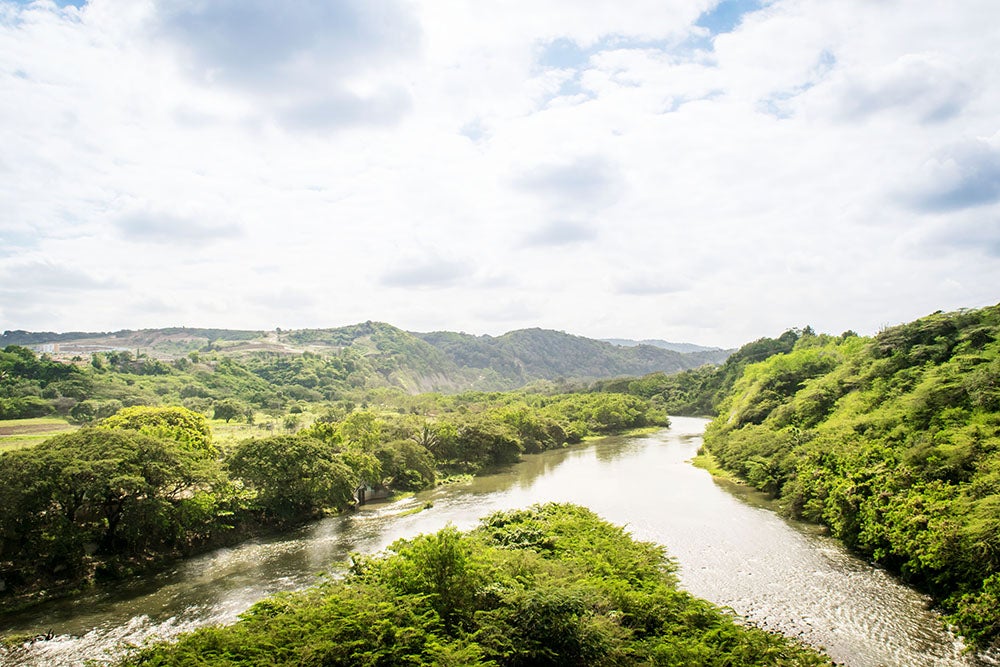
Tucked between the Cordillera Septentrional and Cordillera Central mountain ranges, Santiago de los Caballeros is home to the second-largest urban population in the Dominican Republic and serves as a booming agriculture and industrial trade center. Despite industrial growth, Santiago maintains its presence as an arts and culture capital of the country and retains its colonial history. Winding through the heart of the city is the island’s largest river, El Yaque, connecting Santiago to both mountains and sea. Yet to many today, the Rio Yaque remains forgotten and neglected, with so much of the city’s activity overlooking any impact on the watershed. As Maria Isabel Serrano, the city’s Chief Resilience Officer and Director of Risk explains, “Santiaguinos have turned their back to the river.”
The river appears to offer a natural refuge at first glance, but Santiaguinos are well aware of the trash that mounts at its river banks, the sewage that pours into the river from its many streams, and a sense of insecurity along its edges. A lack of clear land use policies, watershed management, and public stewardship means that the Yaque flows can devastate adjacent communities during extreme weather events. At least 17 people lost their lives in Santiago during Tropical Storm Olga in 2007, and thousands were left without homes. While the Yaque provides life to the region, it also threatens the stability of communities alongside it.
The City government and local stakeholders, in partnership with the Inter-American Development Bank (IADB) and 100 Resilient Cities (100RC), are hoping to unlock the potential of the city through the project Vive el Yaque, aimed at restoring the urban-environmental corridor along the river, to make the urban core more resilient, sustainable, and inclusive. Aligning with the Santiago Resilience Strategy, the project is designed to mitigate flood risk and improve environmental conditions, promote social inclusion, and enhance the urban core. After evaluating different vulnerabilities, risks, climate change, and urban growth, Vive el Yaque seeks to prepare Santiago for the 21st century challenges the city faces.
A recent Resilience Accelerator hosted by 100RC and Columbia University’s Center for Resilient Cities and Landscapes (CRCL), in partnership with the IADB and the City, brought design and research expertise to align with the work underway by local resilience practitioners. Together, we selected three projects under the umbrella of Vive el Yaque:
- the need for informal communities to move out of flood zones, as seen in the community of Suelo Duro;
- an opportunity to reimagine the Bella Vista neighborhood’s connection to the Yaque River through the creation of a natural park, protective levee, and urban drainage system; and
- the opportunity to reimagine the central Mercado Hospedaje market, whose current state of disorganization, as a result of unplanned growth, put stress on authorities; and whose unregulated waste management poses health stresses on residents and market workers.
Over the course of 3 months, CRCL and 100RC met with community leaders, collected global case studies, and prepared a design charette. The charette, delivered in November 2018, included site visits and meetings with community leaders in addition to two days of hands-on workshop. The diverse group of participants – including international and local subject matter experts, government authorities, policy makers, designers, and municipal staff – worked to refine the projects by weighing a number of proposed options against the immediate needs and possible futures of the affected neighborhoods.
Housing Relocation in Suelo Duro – Transitioning Vulnerable Communities Away from Flood Risk

At the workshop, key subject matter experts shared their experience in implementing similar projects. For example, Lymaris de Jesús Pineiro of the Caño Martín Peña project in Puerto Rico recounted her efforts in implementing a process to relocate hundreds of homes away from the San Juan Bay. At Caño Martín Peña, 8 communities organized themselves by creating a manifesto for their relocation process. This manifesto was signed by city and federal government and ensured residents would be part of the process and their property protected through a community land trust. For participants in the Santiago Resilience Accelerator, the experience in Puerto Rico showcased a way for local organizations to trigger the kind of political will needed to resolve the complex challenges associated with illegal settlements, including relocation, affordable housing, and solid waste management, among others. This is critical, as municipal, state, and national agencies follow mandates for different levels of intervention and none are directly responsible for relocation. The workshop also elucidated the importance of recognizing cultural values and emotional attachment when designing relocation projects; and that equally important are education campaigns on risk awareness, as well as the need to promote affordable housing models for a population with no formal income. The workshop laid the groundwork for local organizations like Santiago Solidario to pursue a relocation process similar to that of Caño Martín Peña, organizing the 11 communities situated along the Yaque.
Green Belt Bella Vista – Protecting Urban Residents from Flooding

Santo Domingo’s successful implementation of La Barquita pluvial park, undertaken by the national government, offered a compelling model for the Bella Vista riverfront. Workshop participants learned how important it was for the park in Santo Domingo to be connected to a larger riverfront vision as well as to regional and national actors. With this in mind, an important objective during the Resilience Accelerator involved helping the Santiago team think critically about three particular interventions: a park along the Yaque River that also functions as a buffer zone, a levee to contain flooding and serve as promenade, and a rain sewage system. Participants particularly warmed to the waterfront park design, proposing alternative ways to secure financing options that would make these green spaces sustainable over time – including partnerships with the private sector and the potential of creating small businesses to generate revenue. As a whole, the series of interventions discussed for Bella Vista represent an exciting initial step towards a waterfront ecological corridor along the entire Yaque in Santiago.
Hospedaje Yaque Market – Planning for Urban Growth and Improving Physical Infrastructure

Case studies of how other Latin American cities have addressed market improvement served as a basis for reimagining the Mercado Hospedaje Yaque, a critical produce market in Santiago that dates to the early 20th century. The market’s existing conditions are marked by neglect, pollution, insecurity, and little regulation. Workshop participants recognized that the Mercado Hospedaje could be transformed into a multiple-use site, distinguished by its fair pricing, cultural activities, array of handcrafts, and culinary services. This would position the market as not only a tourist attraction, but also a source of employment for the people of Santiago and a catalyst for improved economic resilience. Most importantly, it was agreed that a participatory planning process would be essential for moving the market into a new future.
The Resilience Accelerator proved to be a critical moment for local actors, including the private sector, academia, the city, and community organizations, to work through barriers and toward more resilient projects which increase quality of life and prosperity for allquiro Santiaguinos. Current and future needs became embedded into project designs, and projects even rebranded themselves: the Natural Park in Bella Vista is now called the Parque Encantado, and the Mercado Hospedaje is being reimagined as the Market for the entire Cibao region. Through an intense process of peer learning, convening stakeholders, and interrogating project designs, the Workshop left each of the projects with a clearer sense of scope and cost, and a community of people committed to their implementation.
